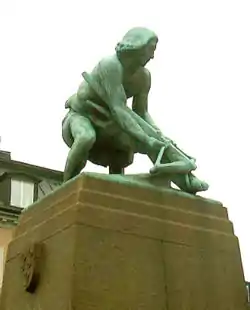Engelbrekt Engelbrektsson
Engelbrekt Engelbrektsson (1390s – 4 May 1436) was a Swedish nobleman and nationalist rebel leader and statesman. He was the leader of the Engelbrekt rebellion in 1434 against Eric of Pomerania, king of the Kalmar Union.[1] Engelbrekt Parish (Engelbrekts församling) and Engelbrekt Church (Engelbrektskyrkan) in the Church of Sweden Diocese of Stockholm were both named in his honor. [2][3]
.png.webp)

Biography
Engelbrekt Engelbrektsson was the owner of a mine and ironworks in the historic mining region of Bergslagen. He was from the parish of Norberg (Norbergs församling) in Västmanland. His family originally came from Germany, having migrated to Sweden in the 1360s.[4] The family coat of arms shows three half-lilies formed into a triangle. [5]
Engelbrekt Engelbrektsson was dissatisfied by the numerous offenses of the Danish local bailiffs and heavy taxation. In 1434 he started a rebellion with the support of mine workers and peasants from his home area. The background was the widespread discontent against the king's bailiff in Västerås, Jösse Eriksson, who was blamed for the distress that mining men suffered under his rule. Following formal complaints made by Engelbrekt on the behalf of the mining men an inquiry was made by Erik of Pomerania which eventually found that Jösse's action were criminal. Despite this Jösse was not replaced which led to a large host of peasants went to Västerås to protest. While the Riksråd intervened to peacefully resolve the protests, no actions were taken against the bailiff. In the spring of 1433 the protests escalated into violence and dalecarlians besieged the bailiff's castle. The Riksråd fired Jösse and replaced him with Hans von Eberstein. However, Engelbrekt was not satisfied since Jösse had not been prosecuted for his admitted crimes. A host of dalecarlians and västmanlanders destroyed the castles of Borganäs and Köpingshus. At this point, many nobles joined the rebels. The rebellion grew into a massive force sweeping the country. The uprising took place against the background of the Kalmar Union.[6]
In 1435 Engelbrekt was appointed Rikshövitsman, Commander in chief, at a Riksdag in Arboga that is often considered the first Riksdag in Sweden. However, he was not able to withstand the Swedish nobility, who wanted to exploit the rebellion. He was somewhat forced into the background. The nobility and clergy decided to support Karl Knutsson Bonde, who in 1436 supplanted Engelbrekt as Rikshövitsman.[7] Jösse Eriksson returned to Sweden the same year, but was lynched by peasants in Motala after presenting him to the local thing who condemned him to death.
On 4 May 1436 Engelbrekt was murdered at Engelbrektsholmen, an islet in Lake Hjälmaren, by the aristocrat Måns Bengtsson, who lived in the nearby Göksholm Castle. Måns' father had been involved in a legal dispute with Engelbrekt regarding an illegal burning of a ship. The killing is considered by some historians to have been an assassination. Engelbrekt was buried in Örebro at Saint Nicholas Church.
Måns Bengtsson was a Swedish knight and chief judge in the traditional Swedish province of Närke. He was a member of the family Natt och Dag, a family from Östergötland which belongs to the Swedish noble class.[8][9]
Aftermath

Over the next few decades Engelbrekt became a national hero, depicted as a public protector and an opponent of the Kalmar Union. His rebellion came to be seen as the start of the Swedish national awakening, which would triumph in the following century with the victory of King Gustav Vasa (reigned 1523–1560). Engelbrekt himself had no such ideas, which must have been anachronistic at the time; however his rebellion gave peasants a voice in Swedish politics which they never lost afterwards. The Engelbrekt rebellion caused the unity of the Kalmar Union to erode, leading to the expulsion of Danish forces from Sweden. Although later Danish kings regained influence over Sweden, the rebellion had set a precedent for Swedish claims to sovereignty. [10]
Legacy
- A bronze statue representing Engelbrekt by Swedish sculptor Carl Gustaf Qvarnström was unveiled in Örebro in 1865. [11]
- A statue of Engelbrekt is atop a pillar located outside of Stockholm City Hall
- Carl Georg Starbäck published the novel Engelbrekt Engelbrektsson in two parts in 1868–69. [12]
- Gustaf Wilhelm Gumælius published the poem Engelbrekt in 1858.[13]
- August Strindberg included Engelbrekt in the 1899 five-act play Saga of the Folkungs (Folkungasagan).[14]
- Engelbrekt became the subject of Engelbrekt (1928), an opera by the Swedish composer Natanael Berg (1879–1957).[15]
References
- Engelbrekt Engelbrektsson (Nordisk familjebok / 1800-talsutgåvan. 4. Duplikator – Folkvandringen /499-500. 1881)
- "Om Engelbrekts församling". .svenskakyrkan.se. Retrieved August 1, 2020.
- "Engelbrektskyrkan" (PDF). svenskakyrkan.se. Retrieved August 1, 2020.
- NE (2023): Engelbrekt Engelbrektsson (Nationalencyklopedin. (Link checked 2013-05-13.)
- "Bergslagen". Stiftelsen Ekomuseum Bergslagen. Retrieved August 1, 2020.
- "Bergslagen - Vår historia". Destination Bergslagen. Retrieved August 1, 2020.
- Karl Knutsson (Nordisk familjebok / Uggleupplagan. 13. Johan – Kikare /943-944. 1910)
- Måns Bengtsson – Natt och Dag (Nordisk familjebok / 1800-talsutgåvan. 11. Militärkonventioner – Nådaval /861-862)
- Natt och Dag (Nordisk familjebok / Uggleupplagan. 19. Mykenai – Norrpada / 563–564)
- S. J. Boëthius, Uppsala University. "Om Engelbrekt Engelbrektsson och Betydelsen Af Hans Verk". Stockholm:Beijers Bokförlagsaktiebolag. Retrieved August 1, 2020.
- "Carl Gustaf Qvarnström". Svenskt biografiskt lexikon. Retrieved August 1, 2020.
- "C Georg Starbäck". Svenskt biografiskt lexikon. Retrieved August 1, 2020.
- "Gustaf Wilhelm Gumælius". Svenskt biografiskt lexikon. Retrieved August 1, 2020.
- Strindberg, August (1959). The Saga of the Folkungs: Engelbrekt. google.com. ISBN 9780295739212. Retrieved August 1, 2020.
- "Natanael Berg (1879−1957)". Levande Musikarv. Retrieved August 1, 2020.
Other sources
- Harrison, Dick (2002) Sveriges historia medeltiden (Stockholm: Liber) ISBN 91-47-05115-9
- Moberg, Vilhelm (1971) Min svenska historia, II. Från Engelbrekt till och med Dacke (Stockholm: Norstedt)
- Larsson, Lars Olof (1984) Engelbrekt Engelbrektsson och 1430-talets svenska uppror (P.A. Norstedt) ISBN 978-91-1-843212-5
- Lindkvist, Thomas (1990) Sveriges medeltid (Solna: Almqvist & Wiksell) ISBN 978-91-21-10557-3
- Lönnroth, Erik (1961) Från svensk medeltid (Stockholm: Aldus/Bonniers )